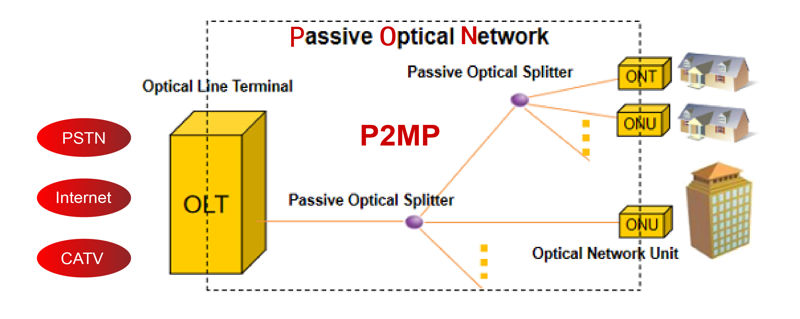Cable & Wire | High quality and excellent service at reasonable prices.
info@zion-communication.com
Author: Site Editor Publish Time: 28-07-2025 Origin: Site
Passive Optical Network (PON) is a telecommunications solution that makes use of fiber-optic cable to provide bandwidth network access to end users with no active components in the carrier's route between a central office of the provider and the end user. This architecture has the capacity to afford high-bandwidth over large distances without solution to old copper wires; it provides an option for the future that will lower maintenance cost of these traditional systems.

Unlike the conventional copper-based networks, like DSL or coaxial cable, that depend on electric signals and are disturbed by electromagnetic flux, PONs employ optical links instead; this implies much more bandwidth and transmission distance. Copper systems need a higher number of active components, which include amplifiers, in order to transmit their signals over long distances. This factor makes it harder to plan and maintain a copper network. On the other hand, PONs use passive optical splitters and hence have no power supply, which greatly reduces operation expenses.
PONs fall under the passive optical category, as there are no powered components between the central office of the service provider and the customer's premises. Electricity, on the other hand, makes up the active optical networks (AONs), which incorporate powered equipment like switches and routers within the distribution path. AONs have scalable capabilities, can route anything, and give close to total control. However, they require electrical power and a complicated infrastructure. PONs, on the other hand, are comprised of a simple design, are low-power consuming, and have fewer failure points.
The abbreviation FTTx embraces related models of fiber installations, varying by how deep the fiber penetrates to an end user, including:
FTTH (Fiber to the Home): Fiber optics goes all the way to the housing premises.
FTTB (Fiber to the Building): Fiber reaches at a building’s point of entrance, supplying users through Ethernet or coaxial cable.
FTTC (Fiber to the Curb): Fiber stops at the edge of the pavement or nearby street cabinet, usually within a few hundred meters from the place, further carried via twisted pair or coaxial cables.
FTTN (Fiber to the Node): Fiber at the central node within the vicinity, moving on to the last-mile delivery via copper wiring.
This configuration offers several alternatives that find bandwidth, cost, and complexity as mutually exclusive.
A typical PON consists of the following key components:
Feeder cable: Running from the central office (CO) or originating point of cable; it has the aggregated signal from the provider to bring new services.
Fiber distribution hub (FDH): It serves as the linking point for feeder cables with distribution cable and utilizes optical splitters, which act as a cross-connection point.
Distribution cable: From FDH to Network Access Point (NAP). They often comprise several fibers.
Drop Cable: This wire connects NAP to the Network Interface Device (NID) within the dwelling place. It normally carries a single fiber for each subscriber.
NAP (Network Access Point): Outside enclosure in which individual fibers are spliced to connect to higher fibers from drops.
NID (Network Interface Device): Customer's premises terminal. Fiber ceases here and connects to the end-user's Optical Network Terminal (ONT).
Each connection between the components in a PON report is formed by the use of passive components with no electrical needs, such as optical couplers and splitters.
The two major PON standardization documents, issued on international level, are as follows.
ITU-T G.984 and G.987: These are the GPON and XG-PON standards from the International Telecommunication Union, with GPON supporting downstream rates up to 2.5 Gbps, and upstream rates of 1.25 Gbps.
IEEE 802.3: It is the IEEE standard specifying Ethernet Passive Optical Network (EPON) and 10G-EPON for 1 Gbps (EPON) or 10 Gbps (10G-EPON) symmetrical speeds for both upstream and downstream traffic.
Optical transceivers, the key elements in PON systems, must follow the specifications of the physical layer as defined in the GPON and EPON standards:
1000BASE-PX10:
Reach of up to 10 km.
Transmission at 1310 nm and receiving at the 1490 nm wavelength,
This transceiver is a common means or way of conveying information in a passive network.
1000BASE-PX20:
You could be traveling for 20 km or more.
Same wavelengths as 1000BASE-PX10.
This transceiver is used in a passive network.
Besides providing broadband connectivity, a PON may be used for transmitting RF over Fiber (RFoF) signals as well, such as 1)
Analog video distribution, especially in multi-dwelling units (MDUs).
Wireless antenna backhaul allowing radio signals to travel long distances with minimal application range.
Radio frequency signals are transmitted via optical modulation for:
RFoF grants long links for CATV and mobile wireless services by preserving signal quality and upholds various frequencies.
Category | Tool Name | Description | Typical Use |
Cable Preparation | Fiber Cable Stripper | Strips outer jacket and buffer tube without damaging fibers | Cable prep before splicing |
Buffer Tube Stripper | Precisely removes buffer layer around fiber cores | Exposing bare fiber | |
Kevlar Scissors | Designed to cut aramid yarn (Kevlar) strength members | Cutting fiber reinforcement | |
Cable Sheath Cutter | Circular/longitudinal cutter for outer sheaths | Prepares distribution and drop cables | |
Fish Tape / Cable Puller | Used to guide cables through ducts/conduits | Routing drop cables into buildings | |
Cable Ties & Fasteners | For securing cables neatly in pathways | Cable management | |
Splicing & Termination | High-Precision Fiber Cleaver | Produces clean, flat fiber ends for fusion or mechanical splicing | Essential for low-loss splicing |
Fusion Splicer | Welds two optical fibers together using an electric arc | Fusion splicing (FTTH, GPON, EPON) | |
Mechanical Splice Kit | Alignment sleeve and gel to connect fibers without fusion | Quick, low-cost temporary/permanent joints | |
Heat Shrink Oven / Heater | Heats protective sleeve after splicing | Secures and protects fusion joints | |
Field Termination Tool Kit | For installing field-terminated connectors | Pre-connectorized drop cables | |
Cleaning Wipes & Swabs | Alcohol or dry wipes to clean fiber ends and connectors | Prevents signal loss from dust/oil | |
Fiber Holder / Clamp | Secures fiber ends during cleaving or splicing | Precision work holding | |
Testing & Verification | Optical Light Source (OLS) | Emits known light signal (1310/1490/1550 nm) | Used with OPM to measure insertion loss |
Optical Power Meter (OPM) | Measures optical signal power in dBm | Verifies signal strength | |
OTDR (Optical Time Domain Reflectometer) | Analyzes fiber link characteristics, detects loss/splice/faults | Troubleshooting and certification | |
PON Power Meter | Specialized for PON, measures 1310/1490/1550 nm live signals | GPON/EPON verification | |
Visual Fault Locator (VFL) | Emits red laser light to detect breaks, bends visibly | Short-distance fault detection | |
Fiber Identifier | Detects live traffic in fiber without disconnection | Non-invasive testing | |
Terminal Installation | Splitter Mounting Kit | For installing optical splitters in NAP or ODF | FTTH signal distribution |
ODF Termination Tools | For fixing, labeling, and organizing fibers in patch panels | Central office or data center | |
NAP Closure Tool Kit | Tools for sealing, opening, and arranging fiber splice closures | Outdoor drop point installations | |
FTTH Faceplate Installation Kit | Tools for indoor wall outlet installation | User-side connection | |
Waterproof Terminal Box Tools | Used for mounting and sealing outdoor distribution boxes | Harsh or outdoor environments | |
Safety & Support | Safety Glasses | Protects eyes from fiber shards or arc flash | Safety during splicing and cutting |
Anti-Static Gloves | Prevents contamination and static discharge | Handling connectors/fiber | |
Reel-Type Fiber Cleaner | Cassette-style cleaner for ferrules and connectors | Routine cleaning maintenance | |
Fiber Work Mat | Anti-slip mat for working surface | Organizes fiber tools | |
Fiber Scrap Collector | Safely stores discarded fiber shards | Clean and safe workspace |
Passive Optical Networks are transforming the access network by giving increased speed, reliability, and expansion of broadband connections and at the same time reducing the power need and the maintenance service. With homogenized designs, effective optical units, and support for all types of FTTx connections, PONs turns to be a perfect solution for modern living spaces, work places, and industries.
Contact us for more information

James is a technical manager and associate at Zion Communication.
Specializes in Optical Fiber communications, FTTH Solutions,
Fiber optic cables, ADSS cable, and ODN networks.
james@zion-communication.com
+86 13777460328
